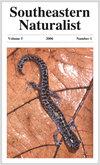Insights on the Distribution of Mussels (Bivalvia: Unionida) in the Moro Creek Watershed, Arkansas
IF 0.4
4区 环境科学与生态学
Q4 BIODIVERSITY CONSERVATION
引用次数: 0
Abstract
Abstract - The distribution of mussels is known from most major water bodies in the United States. Even so, the distribution of mussels in tributary systems of these water bodies is not well documented, especially in Arkansas. Moreover, there has never been a watershed-wide mussel survey in the Moro Creek watershed. During a recent study of fishes in this watershed, we observed 5 mussel species at 12 sites: Lampsilis hydiana (Louisiana Fatmucket), Sagittunio subrostratus (Pondmussel), Pyganodon grandis (Giant Floater), Toxolasma texasiense (Texas Lilliput), and Uniomerus declivis (Tapered Pondhorn). We observed a total of 34 live individuals and 8 fresh-dead specimens. The most abundant species documented was the Tapered Pondhorn, with18 (13 alive and 5 fresh-dead) individuals at 5 sites. The least abundant species was Giant Floater, with 1 individual at 1 site. There was evidence of recent recruitment in 2 species, Tapered Pondhorn (median total length [TL] = 71 mm; min–max = 28–99 mm), and Texas Lilliput (median TL = 21 mm; min–max = 13–40 mm). Future studies that target tributaries of the Ouachita, Red, and St. Francis drainages of Arkansas are likely to yield new distributional records for these species as well as others.阿肯色摩罗溪流域贻贝分布的见解(双壳目:Unionida)
摘要-贻贝的分布是已知的,从大多数主要的水体在美国。即便如此,这些水体支流系统中贻贝的分布并没有很好的记录,尤其是在阿肯色州。此外,在莫罗溪流域从未对整个流域的贻贝进行过调查。在最近的鱼类研究中,我们在12个地点观察到5种贻贝:Lampsilis hydiana (Louisiana Fatmucket), Sagittunio subrostratus (pond贻贝),Pyganodon grandis (Giant flater), Toxolasma texasiense (Texas Lilliput)和Uniomerus declivis(锥形池塘角)。我们共观察到34只活的个体和8只新鲜死亡的标本。记录到的最丰富的物种是锥形池塘角,在5个地点有18只(13只活的,5只刚死的)。最不丰富的物种是巨型飞禽,在1个地点只有1个个体。有证据表明,在2个物种中,锥形塘羚(中位总长度[TL] = 71 mm;min-max = 28-99 mm)和Texas Lilliput(中位TL = 21 mm;最小-最大= 13-40毫米)。未来针对阿肯色州瓦希托河、雷德河和圣弗朗西斯河支流的研究可能会为这些物种以及其他物种带来新的分布记录。
本文章由计算机程序翻译,如有差异,请以英文原文为准。
求助全文
约1分钟内获得全文
求助全文
来源期刊

Southeastern Naturalist
环境科学-生态学
CiteScore
1.20
自引率
16.70%
发文量
31
审稿时长
18-36 weeks
期刊介绍:
The Southeastern Naturalist covers all aspects of the natural history sciences of terrestrial, freshwater, and marine organisms and the environments of the southeastern portion of North America, roughly bounded from North Carolina south to Florida, west to Texas, north to Oklahoma, and east back to North Carolina. Manuscripts based on field studies outside of this region that provide information on species within this region may be considered at the Editor’s discretion.
 求助内容:
求助内容: 应助结果提醒方式:
应助结果提醒方式:


